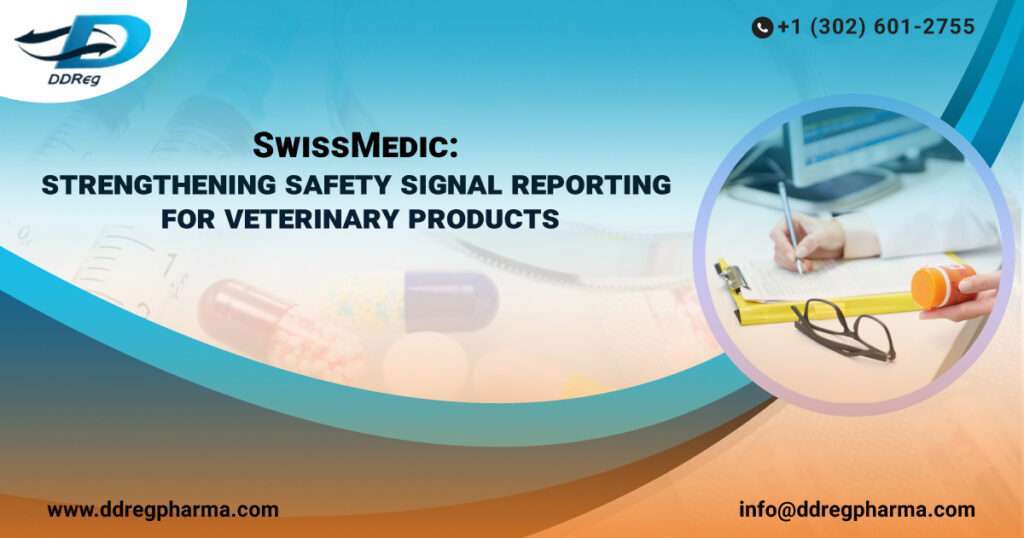Efficiently detecting safety signals for veterinary products is crucial for safeguarding animal health and ensuring the well-being of both animals and humans. Rapid identification of potential risks allows for timely intervention, preventing widespread harm. Recognizing the significance of this, global authorities are actively working to fortify safety signal reporting. Establishing regulatory guidelines ensures a standardized approach, fostering consistency and transparency in reporting practices. By promoting collaboration between regulatory bodies, manufacturers, and veterinarians, these efforts strive to enhance the overall safety profile of veterinary products. Strengthened safety signal detection not only protects animal welfare but also upholds public confidence in the veterinary pharmaceutical industry.
SwissMedic: Support MAHs for Signal Reporting and Risk Management
Collecting and analyzing reports of suspected adverse reactions to veterinary medicinal products has a significant role in the regulatory process. This information contributes to understanding the adverse effects of veterinary medicines, refining safety profiles, and enabling necessary modifications to marketing authorizations. Recently, SwissMedic released a new guidance document titled “Drug safety signals VMP” to streamline the reporting obligations of Marketing Authorization Holders (MAH) and the implementation of risk-minimizing measures.
SwissMedic aligns its practices with the European Guideline on veterinary good pharmacovigilance practices (GVP) Module Signal Management, providing a comprehensive framework for managing signals, including scientific, quality-related, and regulatory considerations. The duty to report drug safety signals and the associated time limits are enshrined in the Therapeutic Products Act (TPA) and the Therapeutic Products Ordinance (TPO).
MAHs are obligated to report safety and efficacy signals impacting the benefit-risk profile of veterinary medicinal products. Signals with a serious risk potential, such as those associated with ongoing clinical studies or regulatory actions in other countries, require immediate reporting within specified time frames.
Prioritization of Signals: Signals are prioritized based on criteria like serious risk potential, medically important terms, recency of the identified association, evidence level, and impact on public health, among others. Emerging safety issues are of particular concern and necessitate swift regulatory action and communication.
Handling Signals: For signals without a serious risk potential, MAHs are required to update product information based on internal signal evaluations. If risk-minimizing measures are needed, the MAH must submit a Signal Notification Form VMP or an application for modification of product information within 60 days of signal closure.
Signals Evaluated by Foreign Authorities: MAHs must inform SwissMedic about signals and safety- or efficacy-related procedures evaluated by foreign authorities, potentially involving medicinal products authorized in Switzerland. This includes reporting the initiation, interim reports, and results with resulting measures.
Signal Reporting Procedure: Signal reports should be submitted to SwissMedic, either by post or through the Safety Portal. The Signal Notification Form VMP is used for initial reports and follow-ups on signals without SwissMedic Signal ID. Submission via the Safety Portal requires specific registration.
Variation Submission and Fees: Once an official decision is issued for a signal, modified medicinal product information must be submitted within 30 calendar days as a variation without assessment C.4. Time-based fees apply for administrative proceedings related to signal processing.
Conclusion
Ensuring the safety of veterinary medicinal products requires a robust system for signal reporting and risk management. Marketing Authorization Holders (MAHs) must promptly report signals impacting product benefit-risk profiles. Prioritization criteria ensure swift action, particularly for serious risks or emerging safety issues. The handling of signals, whether through internal evaluations or regulatory measures, underscores a commitment to public health.
MAHs are required to inform SwissMedic about signals evaluated by foreign authorities, fostering a global approach to pharmacovigilance. The reporting procedure, via traditional means or the Safety Portal, highlights efficiency and standardization.
Variation submissions with associated fees underscore MAHs’ responsibility to promptly update product information. Time-based fees incentivize expedited administrative proceedings, aligning to ensure ongoing safety and efficacy. In summary, these regulations emphasize a proactive and collaborative approach to veterinary pharmacovigilance, prioritizing the well-being of animals and the public.
DDReg has supported its customers with end-to-end and compliant pharmacovigilance services for veterinary products. With the knowledge and experience of working with over 120 global agencies, DDReg provides tailored and customized solutions for post-market safety surveillance. Read from the experts to know more about their capabilities: Understanding the FDA’s Abbreviated New Animal Drug Application Pathway.

